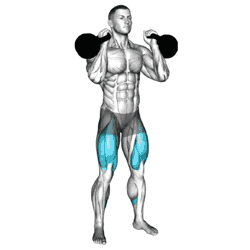Kettlebell Front Squat for Total-Body Strength
Instructions:
-
Setup:
- Start by holding a kettlebell with both hands in a "rack position."
- To get into the rack position, clean the kettlebell to the front of your shoulder. Your elbows should be high and pointing forward, creating a stable "shelf" for the kettlebell.
- Keep your feet shoulder-width apart with your toes slightly turned out.
- Engage your core and maintain a neutral spine.
-
Descending into the Squat:
- Begin by pushing your hips back slightly and then bend your knees to lower your body.
- Keep your chest up and your elbows pointing forward throughout the movement. Avoid letting your elbows drop or your chest collapse forward.
- Lower yourself until your thighs are parallel to the ground (or deeper, if flexibility allows) while maintaining a strong core and a neutral back.
-
Bottom Position:
- At the bottom, your knees should be tracking over your toes and your hips should be below or just parallel to your knees.
- Maintain an upright torso, avoiding rounding your back or leaning too far forward.
-
Rising Back Up:
- Push through your heels to return to the starting position.
- Drive your hips forward and extend your legs, keeping the kettlebell stable and the elbows high.
- Focus on keeping your core tight and using your glutes and quads to stand up.
-
Repeat:
- Perform the desired number of reps, keeping your form consistent for each one.
Tips
-
Grip and Rack Position:
- Make sure your grip on the kettlebell is firm but relaxed enough so you’re not straining your arms. Your forearms should be vertical to create a stable shelf for the kettlebell.
- If you find the kettlebell is uncomfortable or you can’t maintain the rack position, you can use two kettlebells (one in each hand) in a rack position, which may feel more stable for some people.
-
Core Engagement:
- Keeping your core engaged is critical to protecting your lower back and maintaining proper posture. Draw your navel towards your spine as you squat, creating tension throughout the torso.
-
Foot Position:
- Keep your feet flat on the floor, with the weight evenly distributed across your whole foot. Ensure that your knees track in line with your toes, avoiding them caving in.
-
Squat Depth:
- Don’t sacrifice depth for form. Go as deep as you can with good technique, ideally reaching parallel or lower. If your mobility doesn’t allow for a full squat, work on improving your ankle and hip flexibility gradually.
-
Elbow and Chest Position:
- Keep your elbows up and forward. If your elbows drop, the kettlebell may shift forward, causing you to lean too far forward. This can place strain on your back and make it harder to maintain balance.
-
Breathing:
- Take a deep breath before starting the movement (bracing your core), and exhale as you push through the squat and return to standing.
-
Progression:
- Start with a lighter kettlebell and focus on mastering the movement before increasing the load. As you progress, gradually increase the weight to challenge your strength.








